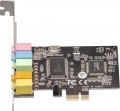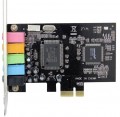Standards
Various standards and special digital audio technologies that the sound card is officially compatible with. For example, the Dolby and DTS standards in various variations are used primarily for multi-channel audio tracks in films, while DirectSound and EAX provide high-quality “surround” sound in games. In fact, the ability to work with one or another standard is largely determined by the software part of the system, and not by the characteristics of the sound card; however, official compatibility means at least the full compliance of the card with the requirements of the standard and the minimum risk of conflicts at the hardware level.
DAC resolution
The bit depth of the digital-to-analogue converter (DAC) of the sound card. In this case, DAC refers to a part of the circuit that converts digital sound data (machine code) into analogue pulses that are fed directly to an external device — speakers, headphones, etc. The bit depth is one of the main parameters (along with the sampling frequency) that describes the quality of the DAC: the higher it is, the more reliable the sound will be reproduced, the less distortion will be introduced into it during conversion.
16-bit DACs usually have entry-level sound cards — this is enough for good sound quality. In other cases,
24-bit converters are most common, and even for advanced models, in particular gaming ones (see "View"), they are almost mandatory.
Max. sampling rate
The highest sampling rate provided by the digital-to-analogue converter (DAC) of the audio card. For more details on the role of the DAC, see paragraph "Bit depth" above. Here we note that the quality of its work directly depends on the sampling frequency: the higher it is, the less distortion occurs when converting sound.
Usually in sound cards there are standard values for the maximum sampling rate:
44.1 kHz — corresponds to the sound quality of Audio CD;
48 kHz — DVD;
96 kHz — DVD-Audio 5.1;
192 kHz — DVD-Audio 2.0 (two-channel audio has a higher sampling rate than multi-channel audio for a number of reasons), the highest value in modern consumer-grade sound cards.
Another specific point is that the quality of sound played on a computer cannot be higher than the capabilities of a sound card. In other words, if an audio file is recorded at a higher sampling rate than the audio card can provide, its sound quality will be reduced: for example, on a 44.1 kHz card, even DVD-Audio sound will sound like an Audio CD. Therefore, if you want to fully enjoy high-quality sound, you should choose a model with a high sampling rate.
Signal-to-noise ratio
This parameter determines the ratio of the "clean" sound produced by the DAC at the output to all extraneous noise. As such, it is a pretty strong indicator of sound purity. According to the signal-to-noise ratio, DACs in modern sound cards can be divided as follows:
up to 90 dB — initial level;
90-100 dB — average level, advanced "home" models;
more than 100 dB — professional level.
ADC resolution
The bit depth of the analogue-to-digital converter (ADC) of the sound card. An ADC is a module that encodes an analogue audio signal into a digital format; it is he who is responsible for transmitting sound "to the computer" — for example, through a microphone when communicating via Skype or from a guitar pickup when recording a track. The bit depth is one of the main parameters that describe the quality of the ADC: the higher it is, the less distortion will be introduced into the digitized sound and the higher the maximum possible quality of its recording. Of course, the properties of the actually recorded sound will depend on many other things (hardware, software, settings, file format, etc.), but for high-quality recording, you will definitely need a good ADC.
A bit depth of
16 bits is considered quite sufficient for everyday use, however, even fairly simple models of audio cards are increasingly acquiring
24-bit ADCs.
Max. sampling rate
The highest sampling rate that the analogue-to-digital converter (ADC) of a sound card can provide when digitizing sound. Without going into details, we can say that the role of this parameter is almost completely similar to the bit depth described in the paragraph above. And its standard values, found in modern audio cards, correspond to the following sound quality indicators:
44.1 kHz — Audio CD;
48 kHz — DVD
96 kHz — DVD-Audio 5.1
192 kHz — DVD-Audio 2.0 (two-channel audio has a higher sampling rate than multi-channel audio for a number of reasons), the highest value in modern consumer-grade sound cards.
Signal-to-noise ratio
The signal-to-noise ratio provided by the analogue-to-digital converter (ADC) of the sound card in the processed signal. For more information about this ratio, see the paragraph of the same name above. Here we note that in domestic use it does not play a decisive role, but if you plan to record sound in good quality, you should choose a card with a high value of this indicator.
mini-Jack (3.5 mm)
The number of inputs in the design of the sound card using 3.5 mm mini-Jack connectors. This connector, usually used to transmit an analogue signal, is one of the most popular in modern audio technology. Speaking of inputs, it's worth noting that most computer microphones are designed to plug into the 3.5mm jack; this also applies to separate microphone plugs on headsets. At the same time, the specific purpose of the mini-jack sockets in different sound cards may be different; Moreover, in some models, the same socket can be reconfigured and even change its purpose (from input to output and vice versa). These points, usually, are specified in the characteristics.
Using a simple adapter, you can also connect a 6.35 mm plug (Jack) to the 3.5 mm jack.
mini-Jack (3.5 mm)
The number of outputs with
3.5 mm mini-Jack connectors in the design of the sound card. It is this connector that is used by the vast majority of modern computer headphones and speakers of all price categories (although it is relatively rare in top-end technology), and it is very popular in other consumer-class audio devices. Therefore, almost all entry-level and mid-level sound cards have at least one 3.5 mm jack; the absence of such outputs is typical for specialized models (for example, DAC, see "View"). Also note that a single mini-jack output can work with a maximum of two channels, however, this interface is also used in multi-channel sound systems — in this case, the audio card is equipped with several connectors, each of which is responsible for its own part of the system. For example, for 5.1 systems, one connector is allocated to the centre, one to a pair of front channels, one to a pair of rear channels, and one to a subwoofer.
As with 3.5mm inputs (see above), this type of output can be used in a variety of ways and can even be configurable.

